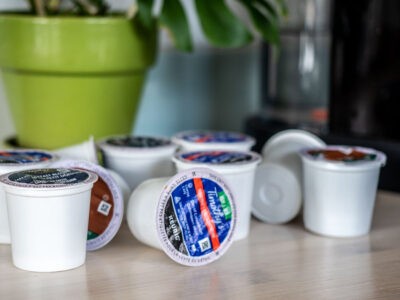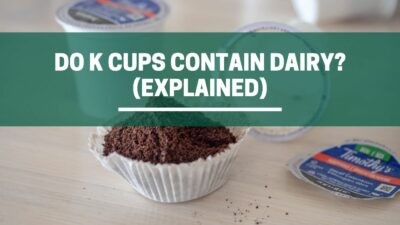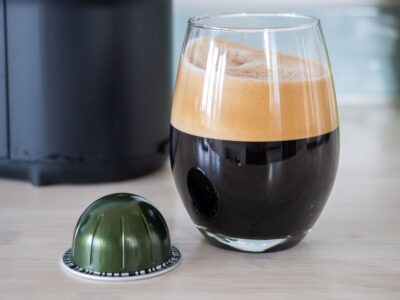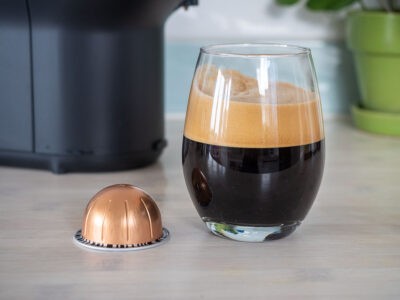Keurig Guides, Keurig Machines
How To Descale Keurig With Vinegar (We Tested)
When your Keurig produces coffee with a strange taste and odor, you know it’s time to descale it. But the cost of commercial descalers can make you dread the entire process. Luckily, you can use vinegar. Its mild abrasiveness makes it an ideal natural household cleaner, but how do you descale your machine with it?
Here’s a quick run-down:
- Fill the water reservoir halfway with regular white vinegar and the other half with water. (We’ve found it’s crucial to use to a 1:1 ratio)
- Place a mug on the drip tray, enter descaling mode and select the largest cup size brew.
- Fill the water reservoir with plain water and run several rinse cycles.
- Now you’re ready to brew your coffee.
Join us as we explore the pros and cons of using vinegar, as well as a couple of tips and tricks to ensure you use it properly.
Why Listen To Us? Well, because we KNOW coffee! In fact, we make our own coffee, coffee machine cleaners, and reusable capsules which we've sold to over 41 countries. Our team ouf experts include Tristan (an engineer), Claire (a food writer) and Richy (a barista). So, whether you're looking for a recipe or repair guide, we've got you covered 💚
Table of Contents
How to Clean Keurig Machine With Vinegar
You’ll Need:
- 16oz/ 473ml white vinegar
- 16oz/ 473ml water
- Large mug
- A damp cloth
Preparation
- Remove the water filter and any used pods.
- Fill the water reservoir with vinegar and water.
- Place the mug on the drip tray.
Clean Cycle
- Select the largest cup size and start a brew cycle.
- Once the cycle is complete, let the machine sit for about 30 minutes to an hour, allowing the vinegar solution to work its way through the internal components.
- Empty the mug and fill the water reservoir with fresh water to the MAX line.
- Select the largest cup size and brew.
- Rinse three more times to ensure all vinegar residue is flushed out.
- Using a cloth, wipe down the outside of the machine.
What You Can Use to Descale Your Keurig Machine
Vinegar might be a readily (and cheaper) available agent, but you can use other chemicals to clean your machine. Here are some worth exploring.
Use commercial descaling products (Recommended)
Commercial descalers are specifically formulated to descale coffee makers and are often faster and more effective than other methods. They are also less abrasive, so you don’t have to worry about corroding the internal components of your brewer. Our go-to is the Keurig Descaling solution. It’s highly effective, fast acting, and odorless, which means we don’t have to worry about lingering odors transferring into our coffee or the likelihood of a malfunctioning machine.
Use white vinegar
Vinegar is acidic, making it effective at dissolving mineral buildup. It’s a readily available and affordable option too. But, it’s not as potent as commercial descaling products, so you will have to descale several times to remove all the calcium build-up.
Use Citric Acid
Citric acid is a natural ingredient (derived from citrus fruit) that effectively breaks down mineral buildup, without the pungent odor. It’s commonly used in descaling products, but you can purchase it in powder form. But it can be more expensive than white vinegar and may be harder to find in stores.
Use Baking Soda (Not Recommended)
Baking soda is a weak base and not as effective as other descaling methods. It can also leave a residue that is difficult to remove. The residue can clog your machine, requiring you to send the machine for repairs or purchase a new brewer altogether.
Benefits of Using Vinegar for Descaling
- Budget-friendly: It’s readily available in most households and is an affordable alternative to specialized descaling products. It provides a cost-effective solution for maintaining your machine.
- Effective: Vinegar is acidic so it can effectively dissolve limescale and bacteria that can accumulate inside your brewer’s pipes.
- Non-toxic: Vinegar is generally safe to use and does not pose health risks. It’s a food-grade ingredient, making it a safer option compared to harsh chemicals that may leave residues or odors.
Disadvantages of Using Vinegar
- Odor: Vinegar has a strong odor that can linger in your machine if not rinsed thoroughly.
- Mild Acidity: It’s less potent than commercial descaling products, so it may take longer to remove heavy mineral buildup.
- Bad Reputation: Most importantly, vinegar has a reputation of peeling off scale in big chunks or flakes. There have been reports of these chunks getting stuck in your machines pipework and actually causing a blockage, rather than mitigating one. So just be away this is an issue.
How To Descale Your Keurig Machine With Vinegar (Step-By-Step)
You’ll Need
- 16oz/ 473ml white vinegar
- 16oz/ 473ml water
- Large mug
Preparation
- Turn off and unplug your machine.
- Empty the water reservoir and remove the filter.
- Remove any used pods.
- Fill the water reservoir with vinegar and water.
Descale Cycle
- Place the mug on the drip tray.
- Select the largest cup size and brew as you normally would.
- Repeat until the water reservoir is empty.
Rinse Cycle
- Rinse the water reservoir and fill it with plain water to the MAX line.
- Place the mug on the drip tray.
- Select the largest cup size and run several rinse cycles (3-5) to ensure all the vinegar is flushed out.
Download: Get a copy of our descaling cheatsheet below.
How much vinegar do you use to descale a Keurig machine?
The best vinegar-to-water ratio is 1:1. Fill the water reservoir halfway with white vinegar and the other half with water.
Our Comparison Between Vinegar and Commercial Descaler
Commercial descalers are faster and more effective at removing limescale than vinegar, but they tend to be more expensive. Vinegar is safe, affordable, and readily available. Because it’s mildly acidic and has a pungent smell, we found we have to perform multiple descale and rinse cycles to ensure all the calcium buildup and odor are eliminated. If you have heavy mineral buildup or want a faster descaling process, it’s best to use a commercial descaling product.
Our 3 Tips for Descaling with Vinegar
- Descale Regularly
- Use the Correct Vinegar to Water Ratio
- Rinse Thoroughly Afterward
1. Descale Regularly
Regular descaling with vinegar can help prolong the lifespan of your Keurig machine. It helps prevent clogs, improve water flow, and maintain optimal brewing conditions. This ensures you always enjoy a pleasant cup of coffee. As recommended by Keurig, it’s best to descale your machine every three to six months.
2. Use the Correct Vinegar to Water Ratio
Using too much vinegar can damage your machine, and using too little might not dissolve all the mineral buildup. We recommend you use a vinegar-to-water ratio of 1:1. This translates to about 16oz/473 ml vinegar and 16oz/473 ml water.
3. Rinse Thoroughly Afterwards
As mentioned, vinegar does have a strong odor, and if you don’t take the time to rinse thoroughly, the odor lingers and can transfer into your cup, affecting the quality of your coffee. After descaling, run several water-only brews to flush out all the residue.
Frequently Asked Questions
1. How do I know my Keurig machine needs descaling?
Here are a few signs your machine needs descaling:
- A slow water trickle or a machine that takes too long to fill a cup or doesn’t fill it all the way.
- If you’re experiencing lingering tastes from previous brews, that just won’t disappear no matter how many rinsing cycles you do.
- You’re finding granules in your freshly brewed mug.
- When you see the descale prompt on your Keurig machine.
2. Will a dirty Keurig make bad coffee?
A dirty Keurig machine can affect the quality of your coffee. Mineral buildup can clog the machine’s internal components, leading to slower water flow and a weaker, less flavorful coffee.
3. Does vinegar damage Keurig machines?
Vinegar is safe for use in Keurig machines, but using too much vinegar can damage the internal components of your machine. If you’re descaling your machine with vinegar, it’s best to use equal part water and vinegar. Theres also been reported cases where the scale flakes of in chucks and this ends up blocking the machine further, so just be aware.
4. How much vinegar should I use when cleaning my Keurig machine?
The best vinegar-to-water ratio for when cleaning your Keurig machine is 1:1. This translates to about 16oz/473 ml vinegar and 16oz/473 ml water.
5. Can I use my Keurig machine before it dries after cleaning?
You can use your Keurig machine before it dries after cleaning.
6. Can I use baking soda to clean my Keurig machine?
You can use baking soda to clean your machine, but it’s not recommended. Baking soda is an alkaline substance and may not effectively remove mineral deposits from your machine. Also, baking soda may leave a residue that’s hard to remove, which can clog your machine and compromise its performance.
Final Thoughts And Recommendations
Maintaining your Keurig machine is crucial to ensure it produces high-quality coffee. By descaling your machine regularly, you can remove mineral buildup and bacteria growth, which can affect the taste and aroma of your coffee. Using vinegar is a cost-effective way to descale your brewer, and by following our tips on using the agent properly, you can experience a perfect brew while your machine maintains its peak performance.
That said, using vinegar is not as strong as commercial descalers and also leaves a strong vinegary taste in the machine
We recommend using this Eco Descaler instead. Its comes with 4 sachets (1 year’s supply) which are perfectly portioned. Its environmentally friendly, and it’s also more cost-effective than the name-brand Nespresso Descaler.
You can get it from Amazon here.
- ✔️ ENJOY BETTER TASTING COFFEE: Infrequent descaling is the #1 reason your coffee is tasting bad. Descale and you’ll taste the difference.
- ✔️ SAFE FOR YOU AND YOUR MACHINE: Our Eco Descaler is safe for all machine parts. It leaves no harmful residues and does not cause corrosion within the coffee machine.
- ✔️ WORKS ON ALL COFFEE MACHINES: Designed and tested on all leading coffee machines including Nespresso, Keurig, Dolce Gusto, Caffitaly, Breville, Delonghi, and more.









